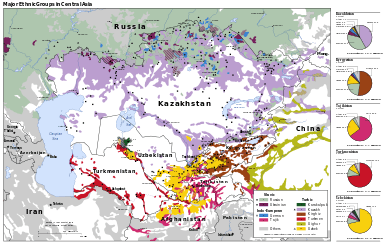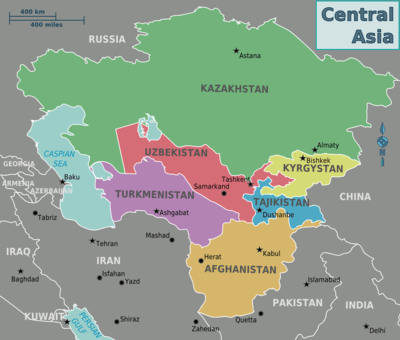Demographics of Central Asia
Central Asia is a diverse land with many ethnic groups, languages, religions and tribes. The nations which make up Central Asia are five of the former Soviet republics: Kazakhstan, Kyrgyzstan, Turkmenistan, Tajikistan, and Uzbekistan, which have a total population of about 72 million.[1][2] Afghanistan is not always considered part of the region, but when it is, Central Asia has a total population of about 122 million (2016).[1][2] Most central Asians belong to religions which were introduced to the area within the last 1,500 years, such as Sunni Islam, Shia Islam, Ismaili Islam, Tengriism, and Syriac Christianity.[3] Buddhism, however, was introduced to Central Asia over 2,200 years ago, and Zoroastrianism, over 2,500 years ago.[4]


Ethnic groups
The below are demographic data on the ethnic groups in Central Asia [3]
| Ethnic Group | Center of population in Central Asia | Total roughly estimated population in Central Asia |
|---|---|---|
| Uzbek | Uzbekistan, Afghanistan, Tajikistan, Kyrgyzstan, Turkmenistan, Kazakhstan | 29,000,000 |
| Tajik | Tajikistan, Uzbekistan and Afghanistan. It includes the Pamiri people, who are officially categorized as Tajiks in Tajikistan. | 25,000,000 |
| Kazakh | Kazakhstan, Uzbekistan | 16,500,000 |
| Kyrgyz | Kyrgyzstan | 4,100,000 |
| Russians | Kazakhstan, Uzbekistan, Kyrgyzstan | 4,000,000 [5][6][7][8] |
| Koreans | Kazakhstan, Uzbekistan, Kyrgyzstan, Turkmenistan, Tajikistan | 500,000 [9] |
| Ukrainian | Northern Kazakhstan | 250,000 [5][7][8] |
| Turkmen | Turkmenistan, Afghanistan and Iran | 6,500,000 |
| Volga German | Kazakhstan | 200,000[7][8] |
| Uyghur | Northwest China, Eastern Kazakhstan, Uzbekistan, Kyrgyzstan | 13,000,000 |
| Dungan or Hui | Northwest China, Kyrgyzstan | 10,500,000 |
| Bukharian Jew | Uzbekistan | 1,000 |
| Tatar | Uzbekistan | 700,000 |
| Karakalpaks | North western Uzbekistan | 500,000 |
| Bashkirs | Kazakhstan | 30,000 |
| Meskhetian Turks | Kazakhstan | 200,000 |
| Armenians | Turkmenistan, Uzbekistan | 100,000 |
| Altai | Northern Kazakhstan | 10,000 |
| Pashtun | Afghanistan, Northwest Pakistan and Razavi Khorasan in Iran[10] | 12,500,000 |
| Hazara | Central Afghanistan | 3,500,000 |
| Aimak | Central and Northwest Afghanistan | 1,500,000 |
| Nuristani | Far eastern and northern Afghanistan | 200,000+ |
| Belarusians | Northern Kazakhstan | 100,000-200,000 [8] |
| Romanians | Kazakhstan | 20,000 |
| Greeks | Kazakhstan | 30,000 |
| Mordvins | Kazakhstan | 20,000 |
| Moldovans | Kazakhstan | 25,000 |
| Chechens | Kazakhstan | 40,000 |
| Poles | Northern Kazakhstan | 50,000-100,000 |
| Azeri | Kazakhstan and Turkmenistan | 100,000 |
| Chuvash | Northern Kazakhstan | 35,000 |
Genetic history
The ancestry of modern Central Asian populations is significantly derived from the Indo-Iranian and Turkic expansions. Most modern populations can be aligned with either Indo-Iranian or Turkic descent, with ancestry corresponding well with ethnic boundaries.[11] Mongoloid (East Asian) admixture was found to correlate inversely with Alu deletion at the CD4 locus.[12]
Archaeogenetic studies on the remains from Iron Age Pazyryk culture burials suggest that after the end of the Indo-Iranian (Scythian) expansion, beginning in c. the 7th century BC, there was a gradual east-to-west influx of East Eurasian admixture to the Western steppes.[13]
Populations of farmers and nomadic pastoralists coexisted in Central Asia since the Chalcolithic (4th millennium BC). The two groups differ markedly in descent structure, as pastoralists are organized in exogamous patrilineal clan structures, while farmers are organized in extended families practicing endogamy (cousin marriage). As a consequence, pastoralists have a significantly reduced diversity in patrilineal descent (Y-chromosome) compared to farmers.[14]
Religion
| Religion[3] | Approximate population | Center of population |
|---|---|---|
| Sunni Islam | 103,000,000[15][16][17][18][19][20] | South and East of region: Tajikistan, Turkmenistan, Kyrgyzstan, Uzbekistan, Afghanistan, Eastern Xinjiang and Southern Kazakhstan.(most dense in Afghanistan and Uzbekistan) |
| Buddhism | 9,084,000[21][22][23][24][25] | 500,000 in Russia, 8.44 million in Xinjiang, 140,000 people in Kazakhstan and Afghanistan; (Mongols, Koreans, Daur, Mongour, Tungusic peoples, Tibetans, Tuvans, Yugur) |
| Shia Islam | 4,000,000 | Hazaras, Central Afghanistan |
| Eastern Christianity | 4,000,000 | Northern Kazakhstan |
| Atheism and Irreligion | 2,500,000+ | Throughout the region |
| Western Christianity | 510,000 | Kazakhstan |
| Judaism | 27,500 | Uzbekistan |
| Zoroastrianism | 10,000 | Historically Afghanistan |
See also
- Indo-Aryan migration hypothesis
- Turkic migration
- History of the Jews in Central Asia
References
- ""World Population prospects – Population division"". population.un.org. United Nations Department of Economic and Social Affairs, Population Division. Retrieved November 9, 2019.
- ""Overall total population" – World Population Prospects: The 2019 Revision" (xslx). population.un.org (custom data acquired via website). United Nations Department of Economic and Social Affairs, Population Division. Retrieved November 9, 2019.
- "The World Factbook — Central Intelligence Agency". Cia.gov. Retrieved 11 January 2018.
- "Archived copy". Archived from the original on 2009-09-25. Retrieved 2010-02-18.CS1 maint: archived copy as title (link)
- "Archived copy". Archived from the original on 2010-03-24. Retrieved 2009-01-02.CS1 maint: archived copy as title (link)
- "Archived copy". Archived from the original on 2011-08-25. Retrieved 2012-07-22.CS1 maint: archived copy as title (link)
- "Archived copy" (PDF). Archived from the original (PDF) on 2009-02-06. Retrieved 2012-01-17.CS1 maint: archived copy as title (link)
- "Archived copy". Archived from the original on 2010-03-16. Retrieved 2013-05-02.CS1 maint: archived copy as title (link)
- Alekseenko, Aleksandr Nikolaevich (2000). Республика в зеркале переписей населения[Republic in the Mirror of the Population Censuses] (PDF). Population and Society: Newsletter of the Centre for Demography and Human Ecology (in Russian). Institute of Economic Forecasting of the Russian Academy of Sciences (47): 58–62. Retrieved 18 March 2019.
- "Ethnologue report for Southern Pashto: Iran (1993)". SIL International. Ethnologue: Languages of the World. Retrieved 5 May 2012.
- Heyer, E. et al., "Genetic diversity and the emergence of ethnic groups in Central Asia", BMC Genetics 10:49 (2009), doi:10.1186/1471-2156-10-49 "Our analysis of uniparental markers highlights in Central Asia the differences between Turkic and Indo-Iranian populations in their sex-specific differentiation and shows good congruence with anthropological data."
- Khitrinskaya, Yu, et al., "Genetic Differentiation of the Population of Central Asia Inferred from Autosomal Markers", Russian Journal of Genetics 39:10 (2003), 1175–1183.
- González-Ruiz, M., et al., "Tracing the Origin of the East-West Population Admixture in the Altai Region (Central Asia)", PLOS x (9 November 2012), doi:10.1371/journal.pone.0048904.
- Chaix, R., et al., "From Social to Genetic Structures in Central Asia", Current Biology 17:1 (January 2007), 43–48, doi:10.1016/j.cub.2006.10.058.
- Min Junqing. The Present Situation and Characteristics of Contemporary Islam in China. JISMOR, 8. 2010 Islam by province, page 29. Data from: Yang Zongde, Study on Current Muslim Population in China, Jinan Muslim, 2, 2010.
- Religious Composition by Country, 2010–2050 | Pew Research Center. Pewforum.org (2 April 2015). Retrieved on 2017-01-20.
- "MAPPING THE GLOBAL MUSLIM POPULATION : A Report on the Size and Distribution of the World's Muslim Population" (PDF). Pewforum.org. October 2009. Retrieved 11 January 2018.
- Mapping the Global Muslim Population. A Report on the Size and Distribution of the World’s Muslim Population Archived 2011-08-21 at WebCite. Pew Forum on Religion & Public Life (October 2009)
- "Religious Composition by Country, 2010-2050". Pewforum.org. 2 April 2015. Retrieved 11 January 2018.
- "The World Factbook — Central Intelligence Agency". Cia.gov. Retrieved 11 January 2018.
- "Religious Intelligence - Country Profile: Kazakhstan (Republic of Kazakhstan)". 30 September 2007. Archived from the original on 30 September 2007. Retrieved 11 January 2018.
- "Religious Intelligence - Country Profile: Kyrgyzstan (Kyrgyz Republic)". 6 April 2008. Archived from the original on 6 April 2008. Retrieved 11 January 2018.
- Religious Freedom Page Archived August 29, 2006, at the Wayback Machine
- "Turkmenistan". State.gov. Retrieved 11 January 2018.
- "The results of the national population census in 2009". Agency of Statistics of the Republic of Kazakhstan. 12 November 2010. Archived from the original on 22 July 2011. Retrieved 21 January 2010.